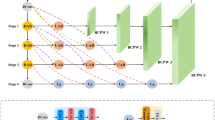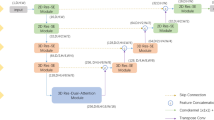Abstract
Accurate lung tumor segmentation has great significance in the treatment planning of lung cancer. However, robust lung tumor segmentation becomes challenging due to the heterogeneity of tumors and the similar visual characteristics between tumors and surrounding tissues. Hence, we developed an improved 3D dense connected UNet (I-3D DenseUNet) to segment various lung tumors from CT images. The nested dense skip connection adopted in the I-3D DenseUNet aims to contribute similar feature maps between encoder and decoder sub-networks. The dense connection used in encoder-decoder blocks also encourages feature propagation and reuse. A robust data augmentation strategy was employed to alleviate over-fitting based on a 3D thin plate spline (TPS) algorithm. We evaluated our method on 938 lung tumors from three datasets consisting of 421 tumors from the Cancer Imaging Archive (TCIA), 450 malignant tumors from the Lung Image Database Consortium (LIDC), and 67 tumors from the private dataset. Experiment results showed an excellent Dice similarity coefficients (DSC) of 0.8316 for the TCIA and LIDC and 0.8167 for the private dataset. The proposed method presents a strong ability in lung tumor segmentation, and it has the potential to help radiologists in lung cancer treatment planning.
Graphical abstract

Framework of the proposed lung tumor segmentation method.









Similar content being viewed by others
References
Siegel RL, Miller KD, Jemal A (2019) Cancer statistics, 2019. CA-Cancer J Clin 69(1):7–3
Punithavathy K, Ramya MM, Poobal S (2015) Analysis of statistical texture features for automatic lung cancer detection in PET/CT images. In 2015 IEEE International Conference on Robotics
Vas M, Dessai A (2017) Lung cancer detection system using lung CT image processing. In 2017 IEEE International Conference on Computing
Zhang GB, Yang ZY, Gong L, Jiang S, Wang L (2019) Classification of benign and malignant lung nodules from CT images based on hybrid features. Phys Med Biol 64(12):125011
Gibaldi A, Barone D, Gavelli G, Malavasi S, Bevilacqua A (2015) Effects of guided random sampling of TCCs on blood flow values in CT perfusion studies of lung tumors. Acad Radiol 22(1):58–69
Ng QS, Goh V (2010) Angiogenesis in non-small cell lung cancer: imaging with perfusion computed tomography. J Thorac Imag 25(2):142–150
Velazquez ER, Parmar C, Jermoumi M, Mak RH, van Baardwijk A, Fennessy FM, Lewis JH, De Ruysscher D, Kikinis R, Lambin P, Aerts HJWL (2013) Volumetric CT-based segmentation of NSCLC using 3D-Slicer. Sci Rep-UK 3:3529
Reeves AP, Chan AB, Yankelevitz DF, Henschke CI, Kressler B, Kostis WJ (2006) On measuring the change in size of pulmonary nodules. IEEE T Med Imaging 25(4):435–450
Goncalves L, Novo J, Campilho A (2016) Hessian based approaches for 3D lung nodule segmentation. Expert Syst Appl 61:1–15
Hosseini-Asl E, Zurada JM, Gimel’farb G, El-Baz A (2016) 3-D lung segmentation by incremental constrained nonnegative matrix factorization. IEEE T Bio-Med Eng 63(5):952-963
Kubota T, Jerebko AK, Dewan M, Salganicoff M, Krishnan A (2011) Segmentation of pulmonary nodules of various densities with morphological approaches and convexity models. Med Image Anal 15(1):133–154
Dehmeshki J, Amin H, Valdivieso M, Ye X (2008) Segmentation of pulmonary nodules in thoracic CT scans: a region growing approach. IEEE T Med Imaging 27(4):467–480
Ganem J, Thureau S, Gardin I, Modzelewski R, Hapdey S, Vera P (2018) Delineation of lung cancer with FDG PET/CT during radiation therapy. Radiat Oncol 13:219
Lian C, Ruan S, Denœux T, Li H, Vera P (2019) Joint tumor segmentation in PET-CT images using co-clustering and fusion based on belief functions. IEEE T Image Process 28(2):755–766
Lei YR, Zheng L, Lyu Z (2018) Lung tumor segmentation and 3D reconstruction based on region growing and correlation. In 2018 International Conference on Computer Information Science and Application Technology
Kasinathan G, Jayakumar S, Gandomi AH, Ramachandran M, Fong SJ, Patan R (2019) Automated 3-D lung tumor detection and classification by an active contour model and CNN classifier. Expert Syst Appl 134:112–119
Nithila EE, Kumar SS (2016) Segmentation of lung nodule in CT data using active contour model and fuzzy C-mean clustering. Alex Eng J 55(3):2583–2588
Kuhnigk JM, Dicken V, Bornemann L, Bakai A, Wormanns D, Krass S, Peitgen HQ (2006) Morphological segmentation and partial volume analysis for volumetry of solid pulmonary lesions in thoracic CT scans. IEEE T Med Imaging 25(4):417–434
Sargent D, Park SY (2017) Semi-automatic 3D lung nodule segmentation in CT using dynamic programming. In Medical Imaging 2017
Diciotti S, Lombardo S, Falchini M, Picozzi G, Mascalchi M (2011) Automated segmentation refinement of small lung nodules in CT scans by local shape analysis. IEEE T Bio-Med Eng 58(12):3418–3428
Khadidos A, Sanchez V, Li C (2017) Weighted level set evolution based on local edge features for medical image segmentation. IEEE T Image Process 26(4):1979–1991
Wang J, Guo HY (2016) Automatic approach for lung segmentation with Juxta-pleural nodules from thoracic CT based on contour tracing and correction. Comput Math Method M :2962047
Reboucas PP, Barros ACD, Almeida JS, Rodrigues JPC, de Albuquerque VHC (2019) A new effective and powerful medical image segmentation algorithm based on optimum path snakes. Appl Soft Comput 76:649–670
Jiang J, Hu YC, Liu CJ, Halpenny D, Hellmann HM, Deasy JO, Mageras G, Veeraraghavan H (2019) Multiple resolution residually connected feature streams for automatic lung tumor segmentation from CT images. IEEE T Med Imaging 38(1):134–144
Zhao XM, Li LQ, Lu W, Tan S (2019) Tumor co-segmentation in PET/CT using multimodality fully convolutional neural network. Phys Med Biol 64(1):015011
Chen W, Wei H, Peng S, Sun J, Qiao X, Liu B (2019) HSN: hybrid segmentation network for small cell lung cancer segmentation. IEEE Access 7:75591–75603
Cao HC, Liu H, Song EM, Hung CC, Ma GZ, Xu XY, Jin RC, Lu JG (2020) Dual-branch residual network for lung nodule segmentation. Appl Soft Comput 86:105934
Wang C, Tyagi N, Rimner A, Hu YC, Veeraraghavan H, Li G, Hunt M, Mageras G, Zhang PP (2019) Segmenting lung tumors on longitudinal imaging studies via a patient-specific adaptive convolutional neural network. Radiother Oncol 131:101–107
Nakano R, Arimura H, Haekal M, Ohga S (2019) Automated segmentation framework of lung gross tumor volumes on 3D planning CT images using dense V-Net deep learning. In International Forum on Medical Imaging in Asia
Liu H, Cao HC, Song EM, Ma GZ, Xu XY, Jin RC, Jin Y, Hung CC (2019) A cascaded dual-pathway residual network for lung nodule segmentation in CT images. Phys Medica 63:112–121
Wang S, Zhou M, Liu ZY, Gu DS, Zang YL, Dong D, Gevaert O, Tian J (2017) Central focused convolutional neural networks: developing a data-driven model for lung nodule segmentation. Med Image Anal 40:172–183
Wu WH, Gao L, Duan HH, Huang G, Ye XD, Nie SD (2020) Segmentation of pulmonary nodules in CT images based on 3D-UNET combined with three-dimensional conditional random field optimization. Med Phys 47:4054–4063
Pezzano G, Ripoll VR, Radeva (2021) PCoLe-CNN: context-learning convolutional neural network with adaptive loss function for lung nodule segmentation, Comput Meth Prog Bio, 198: 105792
Yang JZ, Wu B, Li LT, Cao P, Zaiane O (2021) MSDS-UNet: a multi-scale deeply supervised 3D U-Net for automatic segmentation of lung tumor in CT. Comput Med Imag Grap 92:101957
Xiao ZT, Liu BW, Geng L, Zhang F, Liu YB (2020) Segmentation of lung nodules using improved 3D-UNet neural network. Symmetry-Basel 12:1787
Badrinarayanan V, Kendall A, Cipolla R (2017) SegNet: a deep convolutional encoder- decoder architecture for image segmentation. IEEE T Pattern Anal 39(12):2481–2495
Acknowledgements
We gratefully acknowledge the Second Hospital of Tianjin Medical University for their continuous support in collecting patient data and providing a professional diagnosis.
Funding
This study was funded by the National Natural Science Foundation of China (grant number 81871457), National Natural Science Foundation of China (grant number 51811530310), and National Natural Science Foundation of China (grant number 51775368).
Author information
Authors and Affiliations
Corresponding author
Additional information
Publisher’s note
Springer Nature remains neutral with regard to jurisdictional claims in published maps and institutional affiliations.
Rights and permissions
Springer Nature or its licensor holds exclusive rights to this article under a publishing agreement with the author(s) or other rightsholder(s); author self-archiving of the accepted manuscript version of this article is solely governed by the terms of such publishing agreement and applicable law.
About this article
Cite this article
Zhang, G., Yang, Z. & Jiang, S. Automatic lung tumor segmentation from CT images using improved 3D densely connected UNet. Med Biol Eng Comput 60, 3311–3323 (2022). https://doi.org/10.1007/s11517-022-02667-0
Received:
Accepted:
Published:
Issue Date:
DOI: https://doi.org/10.1007/s11517-022-02667-0




